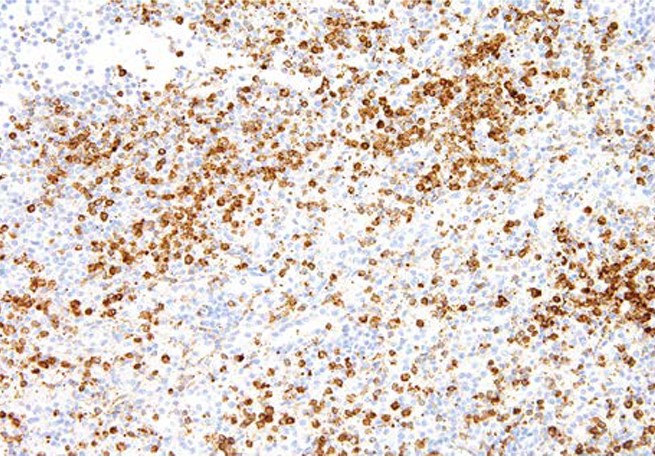Anti-Annexin A1 Antibody (34050)
$236.00
Overview
Product Name Anti-Annexin A1 Antibody (34050)
Description Anti-Annexin A1 Mouse Monoclonal Antibody
Target Annexin A1
Species Reactivity Human
Applications IHC
Host Mouse
Clonality Monoclonal
Clone ID G512.1
Isotype IgG1
Immunogen Recombinant human Annexin A1.
Properties
Form Liquid
Concentration Lot Specific
Formulation Tris buffer, pH 7.3-7.7, 1% BSA, 0.1% sodium azide.
Buffer Formulation Tris
Buffer pH pH 7.3-7.7
Buffer Anti-Microbial 0.1% Sodium Azide
Buffer Protein Stabilizer 1% Bovine Serum Albumin
Format Purified
Purification Purified by immunoaffinity chromatography
Specificity Information
Specificity Human Annexin A1. Reactivity with other species has not been investigated.
Target Name Annexin A1
Target ID Annexin A1
Uniprot ID P04083
Alternative Names Annexin I, Annexin-1, Calpactin II, Calpactin-2, Chromobindin-9, Lipocortin I, Phospholipase A2 inhibitory protein, p35 [Cleaved into: Annexin Ac2-26]
Gene Name ANXA1
Sequence Location Nucleus, Cytoplasm, Cell projection, cilium, Cell membrane, Membrane, Endosome membrane, Basolateral cell membrane, Apical cell membrane, Lateral cell membrane, Secreted, Secreted, extracellular space, Cell membrane, Secreted, extracellular exosome, Cytoplasmic vesicle, secretory vesicle lumen, Cell projection, phagocytic cup, Early endosome, Cytoplasmic vesicle membrane
Biological Function Plays important roles in the innate immune response as effector of glucocorticoid-mediated responses and regulator of the inflammatory process. Has anti-inflammatory activity (PubMed:8425544). Plays a role in glucocorticoid-mediated down-regulation of the early phase of the inflammatory response (By similarity). Contributes to the adaptive immune response by enhancing signaling cascades that are triggered by T-cell activation, regulates differentiation and proliferation of activated T-cells (PubMed:17008549). Promotes the differentiation of T-cells into Th1 cells and negatively regulates differentiation into Th2 cells (PubMed:17008549). Has no effect on unstimulated T cells (PubMed:17008549). Negatively regulates hormone exocytosis via activation of the formyl peptide receptors and reorganization of the actin cytoskeleton (PubMed:19625660). Has high affinity for Ca(2+) and can bind up to eight Ca(2+) ions (By similarity). Displays Ca(2+)-dependent binding to phospholipid membranes (PubMed:2532504, PubMed:8557678). Plays a role in the formation of phagocytic cups and phagosomes. Plays a role in phagocytosis by mediating the Ca(2+)-dependent interaction between phagosomes and the actin cytoskeleton (By similarity). {UniProtKB:P10107, UniProtKB:P19619, PubMed:17008549, PubMed:19625660, PubMed:2532504, PubMed:2936963, PubMed:8425544, PubMed:8557678}.; [Annexin Ac2-26]: Functions at least in part by activating the formyl peptide receptors and downstream signaling cascades (PubMed:22879591, PubMed:15187149, PubMed:25664854). Promotes chemotaxis of granulocytes and monocytes via activation of the formyl peptide receptors (PubMed:15187149). Promotes rearrangement of the actin cytoskeleton, cell polarization and cell migration (PubMed:15187149). Promotes resolution of inflammation and wound healing (PubMed:25664854). Acts via neutrophil N-formyl peptide receptors to enhance the release of CXCL2 (PubMed:22879591). {PubMed:15187149, PubMed:22879591, PubMed:25664854}.
Research Areas Cancer research
Background Annexin A1 (ANXA1) is a membrane protein that plays a role in innate and adaptive immunity by controlling the biosynthesis of inflammation, prostaglandins, and leukotriene mediators. ANXA1 is overexpressed in 97% of samples from patients with hairy cell leukemia and is absent in other B-cell lymphomas. High ANXA1 expression is also associated with advanced stage esophageal and esophagogastric junction adenocarcinoma and has been linked to advanced and metastatic disease.
Application Images


Description Immunohistochemistry: use at a dilution of 1:100-1:200 on formalin-fixed, paraffin-embedded samples after heat-induced epitope retrieval at pH 9 for 10-30 minutes. Detection of Annexin A1 in human spleen with #34050 diluted 1:100-1:200.
Handling
Storage Store at 2-8°C. Do not freeze.
Dilution Instructions Dilute in PBS or medium that is identical to that used in the assay system.
Application Instructions
Immunohistochemistry: use at a dilution of 1:100-1:200 on formalin-fixed, paraffin-embedded samples after heat-induced epitope retrieval at pH 9 for 10-30 minutes.
Immunohistochemistry: use at a dilution of 1:100-1:200 on formalin-fixed, paraffin-embedded samples after heat-induced epitope retrieval at pH 9 for 10-30 minutes.
References & Data Sheet
References Mikels A et al. 2009 J Biol Chem 284: 30167-30176.Wright TM et al. 2009 Oncogene 28: 2513-2523.Edris B et al. 2012 J Pathol 227: 223-233
Data Sheet  Download PDF Data Sheet
Download PDF Data Sheet
 Download PDF Data Sheet
Download PDF Data Sheet


